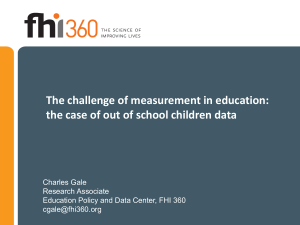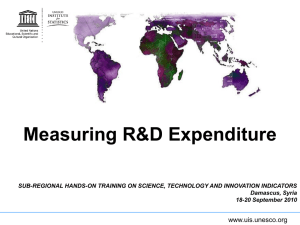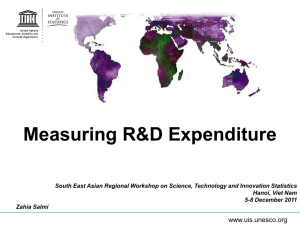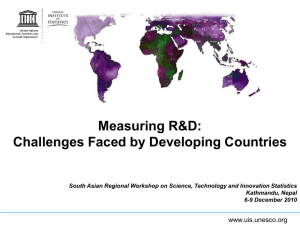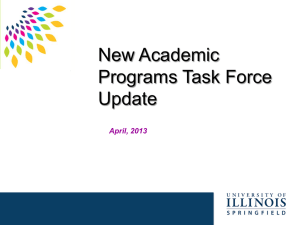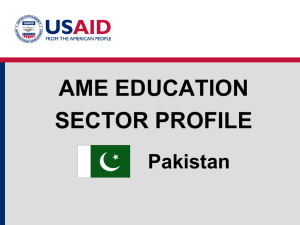Measuring Research and Experimental Development
advertisement
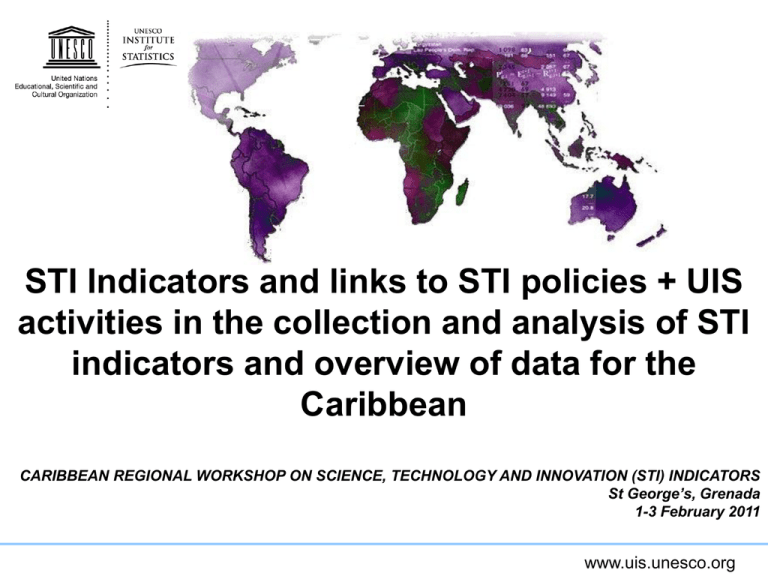
STI Indicators and links to STI policies + UIS
activities in the collection and analysis of STI
indicators and overview of data for the
Caribbean
CARIBBEAN REGIONAL WORKSHOP ON SCIENCE, TECHNOLOGY AND INNOVATION (STI) INDICATORS
St George’s, Grenada
1-3 February 2011
www.uis.unesco.org
Objectives of this presentation
Science policy and the linkage to indicators
Present the work that UIS does to support the
collection and analysis of STI indicators in
developing countries
Provide an overview of the availability of STI
indicators worldwide and in the region
www.uis.unesco.org
Science policy and the
linkage to indicators
www.uis.unesco.org
Science, technology and innovation (STI)
STI universally recognised now as one of the main
drivers of economic growth…
… and therefore of poverty reduction as well
Governments should aim to harness the benefits
of STI
Hence the need for a national STI policy
Integrated in the overall national strategic plan
Coordinated between the various actors that have
a stake (e.g. Ministry of Agriculture, Ministry of
Health, Ministry of Higher Education, etc.)
www.uis.unesco.org
The need for monitoring
Monitoring and benchmarking is critical in
assessing, implementing and evaluating policy
If you don’t know where you are, how do you know
in which direction you need to go?
Policies often include targets: need for (statistical)
measures to assess progress
• E.g. Lisbon target (3%)
• China: 2.5% by 2020
• CPA: 1% in Africa
www.uis.unesco.org
STI policy, evidence/data needed:
indicators to tell a story
Do I need to invest in R&D or in Higher Education?
• Better know how much you are investing already
• What is a convenient and relevant measure?
• % of GDP? Number of graduates?
In which areas should I invest predominantly?
• In which areas am I already investing?
• Which are important economic sectors, in mining, agriculture, industry,
services, etc?
• Which are crucial public sectors, and what are national or regional
peculiarities? (health, environment, utilities, defense,…)
Do I need to improve quality of higher education or research?
• Better know how you compare to other countries
• Are there sufficient links of universities and institutes to industry?
www.uis.unesco.org
Some examples – UNESCO
www.uis.unesco.org
Some examples – EU
The EU innovation Scoreboard is "an
annual assessment of innovation
performance in the individual Member
States of the European Union.
It was an explicit request of the
European Council of Ministers meeting
in Lisbon in March 2000
www.uis.unesco.org
Some examples – OECD
Innovation strategy
www.uis.unesco.org
Some examples – AU/NEPAD
The ASTII Initiative is a programme in
the Africa’s Science and Technology
Consolidated Plan of Action (CPA)
(adopted in 2005) by the African
Ministerial Conference on Science and
Technology (AMCOST), resolving “to
establish an inter-governmental
committee comprising of relevant
national authorities to develop, adopt
and use common indicators to survey
and prepare an African Science,
technology and Innovation report”.
www.uis.unesco.org
Some examples – Latin America
www.uis.unesco.org
UIS activities in the
collection and analysis
of STI indicators
and
Overview of data for the
Caribbean
www.uis.unesco.org
UIS is the UN lead agency for S&T
statistics
Official S&T data source for:
UN Statistical Division: UN Statistical Year Book
UNDP: Human Development Report
World Bank: World Development Indicators
UNESCO Reports:
• UNESCO Science Report
• UNESCO World Report - Towards Knowledge Societies
• International Report on S&T and Gender
www.uis.unesco.org
UIS Strategy on S&T statistics
International Review of S&T Statistics & Indicators 2002-03
Resulting priorities:
Immediate term:
• R&D personnel & expenditure
• Human resources devoted to S&T
• Science education & Higher education
• International mobility
• Gender
Medium term: Innovation data
• Just started!
Longer term: Output & Impact
www.uis.unesco.org
Lines of action
1. S&T survey operation and data guardianship
2. Training in S&T statistics: workshops & other
training activities
3. Standard setting and methodological
developments
4. Analysis and publications
www.uis.unesco.org
1. S&T Survey operation and data
guardianship
Global survey on statistics of science & technology
Global database on S&T Statistics
Data dissemination: on the UIS website and
through contributions to other agencies
2011: pilot survey of innovation data
www.uis.unesco.org
Survey on Statistics of Science &
Technology
Biennially.
2004, 2006 and 2008 S&T surveys completed.
4th round launched in June 2010.
Results released on UIS website
(http://stats.uis.unesco.org).
OECD and Eurostat provide data for their Member States.
RICYT provides data for Latin America and for a few
Caribbean countries.
UIS keeps direct contact with national S&T statisticians.
www.uis.unesco.org
Data collection
R&D Personnel
By sector of employment,
occupation, qualification, and
field of science
In headcount and FTE
By gender
R&D Expenditure
By sector of performance and
source of funds
New: by type of activity and
field of science
www.uis.unesco.org
Data collection in LAC
Antigua and Barbuda
Belize
British Virgin Islands
Dominica
Grenada
Saint Lucia
PM: Netherlands Antilles
Saint Vincent and the Grenadines
Bahamas
Barbados
Cuba
Dominican Republic
Guyana
Haiti
Jamaica
Saint Kitts and Nevis
Suriname
Trinidad and Tobago
Curaçao
Montserrat
Sint Maarten
Peatro Rico
UIS
x
x
x
x
x
x
x
x
RICYT
Not covered
x
x
x
x
x
x
x
x
x
x
x
x
x
x
www.uis.unesco.org
UIS 2008 and 2010 Surveys on R&D:
response rates & published data
Responses
Q 2008
Regions
(Countries and Territories covered)
Responses
Q 2010
Sub-Saharan Africa (45)
20
44%
Arab States-Africa (8)
4
50%
Asia (31, excl. Arab States & OECD)
21
68%
Arab States - Asia (12)
6
50%
Americas (14, excl. RICYT & OECD)
4
29%
0
0%
4
29%
Europe (16, excl. OECD & Eurostat)
11
69%
6
38%
10
63%
Oceania (17, excl. OECD)
4
24%
1
6%
3
18%
70
49%
54
38%
77
54%
45
100%
19
76%
141
66%
Sub-total (143)
45%
63%
16
36%
4
50%
20
65%
7
58%
Published data
38%
63%
26
58%
6
75%
24
77%
4
33%
60%
65%
Data from other sources:
OECD + Eurostat (45)
Total coverage
Total coverage
RICYT (25, incl. 10 Caribbean)
Total (213)
134
63%
118
55%
www.uis.unesco.org
How many researchers are there?
Number of researchers worldwide
2002 (5.8 million)
2007 (7.2 million)
5.0
4.5
4.5
4.0
Researchers (millions)
4.0
3.5
3.0
2.7
2.5
1.8
2.0
1.5
1.0
0.5
0.0
Developed countries
Source: UIS, June 2010
Developing countries
www.uis.unesco.org
How many researchers are there?
Number of researchers worldwide
2002 (5.8 million)
2007 (7.2 million)
1.6
1.4
1.4
1.4
1.3
1.4
1.3
Researchers (millions)
1.2
1.2
1.0
0.9
0.8
0.6
1.0
0.9
0.8
0.7
0.6
0.4
0.2
0.0
EU
Source: UIS, June 2010
USA
Japan
Other
developed
Note: Data for the USA are for 2006 instead of 2007
China
Other
developing
www.uis.unesco.org
Where are researchers located?
Shares of world researchers by principal
regions, 2002 and 2007 (%)
2002 (5.8 million)
North
America,
25.2%
Latin
America &
Caribbean,
2.9%
Africa,
2.3%
Oceania,
2.1%
Asia,
35.7%
2007 (7.1 million)
Europe,
31.9%
North
America,
22.2%
Latin
America &
Caribbean,
3.6%
Africa,
2.3%
Oceania,
2.1%
Asia,
41.4%
Europe,
28.4%
Source: UIS, September 2009
www.uis.unesco.org
Source: UIS estimates, September 2009
3.2%
3.0%
3.0%
2.5%
2.3%
2.3%
2.3%
2.2%
2.1%
2.1%
1.7%
1.8%
1.6%
1.8%
1.2%
1.7%
1.5%
1.4%
0.5%
0.7%
0.8%
0.7%
0.6%
0.6%
0.7%
0.6%
0.5%
0.5%
0.4%
0.4%
0.4%
0.3%
0.2%
0.3%
France
United Kingdom
Africa
India
Oceania
C.E.O. Europe
Other in Asia
Brazil
Arab States (Africa)
Mexico
Egypt
Other Sub-Saharan
C.I.S. Asia
Argentina
Israel
Arab States (Asia)
South Africa
4.6%
4.0%
2.9%
3.6%
0%
L.A.C.
Germany
8.5%
6.6%
10.0%
7.8%
5.0%
6.0%
5%
N.I.E. Asia
Russian Fed.
C.I.S. Europe
11.2%
10.0%
10%
Japan
European Union
15%
20.1%
23.2%
20.3%
20.3%
18.9%
14.0%
20%
China
United States
28.1%
25.8%
25.2%
22.2%
25%
North America
30%
31.9%
28.4%
35%
Americas
40%
35.7%
41.4%
45%
Europe
Asia
Shares of world researchers by principal
regions/countries, 2002 and 2007 (%)
2002
2007
www.uis.unesco.org
Which countries host the greatest number of researchers?
Number of researchers, 2007 or latest available year
Rep. of Korea,
221,928
France,
215,755
India,
154,827
Canada,
139,011
United States,
1,425,550
United
Kingdom,
261,406
Germany,
290,853
Russia,
451,213
Japan,
709,974
Source: UIS, August 2010
China,
1,423,380
www.uis.unesco.org
Researchers in the Caribbean
Researchers in headcount
Total
%
female
per million
inhabitants
per thousand
labour force
Cuba (2008)
5525
48.5
493
1.08
Saint Lucia (1999)
74
33.3
477
1.14
Saint Vincent and
the Grenadines (2002)
21
..
194
0.44
Trinidad and Tobago (2007)
634
38.0
477
0.93
www.uis.unesco.org
What are the national research densities?
Researchers per million inhabitants, 2007 or
latest available year
0 – 100 per million
101 – 300 per million
301 – 1000 per million
1001 – 2000 per million
2001 per million and above
Data not available
Source: UIS, August 2010
www.uis.unesco.org
What are the national research densities?
Researchers per million inhabitants, 2007 or
latest available year
0 – 100 per million
101 – 300 per million
301 – 1000 per million
1001 – 2000 per million
2001 per million and above
Data not available
Source: UIS, August 2010
www.uis.unesco.org
3,000
2,000
1,000
0
Source: UIS estimates, September 2009
Notes: -1 = 2006, -2 = 2005
www.uis.unesco.org
60
136
India -2
Other Sub-Saharan
169
385
South Africa -1
Africa
450
L.A.C.
178
464
Mexico -2
Other in Asia
507
Arab States (Africa)
198
526
C.I.S. Asia
Arab States (Asia)
625
Brazil -1
978
Argentina
654
1,007
N.I.E. Asia
Egypt
1,063
World
742
1,071
China
Asia
1,164
C.E.O. Europe
Americas
2,013
2,515
2,728
European Union
Europe
2,728
2,888
C.I.S. Europe
United Kingdom
3,292
3,442
Germany
Russian Fed.
3,443
France -1
Oceania
4,262
4,654
4,000
North America
5,000
4,707
5,548
6,000
United States -1
Japan
How many researchers are there?
Researchers per million inhabitants, by principal
regions/countries, 2007 or latest year available
The gender gap in science.
Women as a share of total researchers, 2007 or latest
available year
0% – 30%
30.1% – 45%
45.1% – 55%
55.1% – 70%
70.1% – 100%
Data not available
Source: UIS, August 2010
Note: Data in this map are based on HC, except for Congo (based
on FTE).
www.uis.unesco.org
The gender gap in science.
Women as a share of total researchers, 2007 or latest
available year
0% – 30%
30.1% – 45%
45.1% – 55%
55.1% – 70%
70.1% – 100%
Data not available
Source: UIS, August 2010
Note: Data in this map are based on HC, except for Congo (based
on FTE).
www.uis.unesco.org
Gender gap in research career?
Proportion of women and men graduates in tertiary
education and those employed as researchers, 2008
Women
Men
80
Women and men (%)
70
60
50
40
30
20
10
0
Bachelor's degree
Source: UIS, October 2010
Master's degree
PhD degree
Researchers
www.uis.unesco.org
Gross domestic expenditure on R&D (GERD)
worldwide (in Purchasing Power Parity Dollars)
2002 (790.3 billion)
2007 (1145.7 billion)
1000
873.2
900
GERD (in billions PPP$)
800
700
653.0
600
500
400
272.5
300
137.3
200
100
0
Developed countries
Source: UIS, June 2010
Developing countries
www.uis.unesco.org
Gross domestic expenditure on R&D (GERD)
worldwide (in Purchasing Power Parity Dollars)
2002 (790.3 billion)
2007 (1145.7 billion)
400
373
GERD (in billions PPP$)
350
300
277
265
250
206
200
170
148
150
108
102
87
100
98
62
39
50
0
USA
Source: UIS, June 2010
EU
Japan
Other
developed
China
Other
developing
www.uis.unesco.org
Where are R&D investments made?
Shares of world R&D expenditure (GERD) by principal
regions, 2002 and 2007 (%)
2002 (789 billion PPP$)
Europe,
30.3%
Latin
America &
Caribbean,
2.6%
Oceania,
1.4%
Africa,
0.9%
North
America,
37.8%
2007 (1138 billion PPP$)
Asia,
27.1%
Europe,
27.3%
Latin
America &
Caribbean,
2.9%
Oceania,
1.6%
Africa,
0.9%
North
America,
34.7%
Asia,
32.7%
Source: UIS, September 2009
www.uis.unesco.org
Source: UIS estimates, September 2009
www.uis.unesco.org
C.I.S. Asia
Egypt
Arab States (Asia)
Argentina
Other Sub-Saharan
Arab States (Africa)
South Africa
Mexico
Israel
Africa
Other in Asia
Oceania
2002
Brazil
C.E.O. Europe
Russian Fed.
India
C.I.S. Europe
L.A.C.
United Kingdom
France
Germany
0%
N.I.E. Asia
5%
5.0%
9.2%
5.1%
6.4%
7.2%
6.1%
4.8%
3.8%
3.9%
3.3%
2.6%
2.9%
2.3%
2.4%
1.6%
2.2%
2.0%
2.1%
1.8%
1.9%
1.5%
1.6%
1.4%
1.6%
0.6%
0.9%
0.9%
0.9%
0.8%
0.8%
0.5%
0.6%
0.3%
0.4%
0.3%
0.3%
0.2%
0.2%
0.1%
0.2%
0.1%
0.1%
0.1%
0.1%
0.1%
0.1%
10%
China
15%
13.7%
13.0%
20%
Japan
European Union
Europe
25%
27.1%
32.7%
35.1%
32.4%
30.3%
27.3%
26.1%
22.9%
30%
United States
35%
Asia
40%
40.4%
37.6%
37.8%
34.7%
45%
North America
Americas
Shares of world R&D expenditure (GERD) by
principal regions/countries, 2002 and 2007 (%)
2007
World’s top 10 leaders in R&D investment
GERD ( billions PPP$), 2007 or latest available year
United Kingdom,
41.0
India,
24.8
Canada,
24.0
Russia,
23.4
Rep. of Korea,
41.3
United States,
398.1
France,
42.9
Germany,
72.2
China,
102.4
Source: UIS, August 2010
Japan,
147.9
www.uis.unesco.org
A snap-shot of R&D intensity.
Gross domestic expenditure on R&D (GERD) as a
percentage of GDP, 2007 or latest available year
0.00% – 0.25%
0.26% – 0.50%
0.51% – 1.00%
1.01% – 2.00%
2.01% and above
Data not available
Source: UIS, August 2010
www.uis.unesco.org
A snap-shot of R&D intensity.
Gross domestic expenditure on R&D (GERD) as a
percentage of GDP, 2007 or latest available year
0.00% – 0.25%
0.26% – 0.50%
0.51% – 1.00%
1.01% – 2.00%
2.01% and above
Data not available
Source: UIS, August 2010
www.uis.unesco.org
R&D expenditure in the Caribbean
R&D expenditure
Bermuda (1997)
in '000
local
Currency
as a %
of GDP
in constant
2005 PPP
('000)
per capita
(in constant
2005 PPP)
1726
0.06
..
..
Cuba (2008)
304400
0.49
..
..
Jamaica (2002)
286837
0.06
10598
4.1
Saint Lucia (1999)
6814
0.36
4706
30.3
Saint Vincent and
the Grenadines (2002)
1500
0.15
1027
9.5
81100
0.06
17676
13.3
Trinidad and Tobago
(2007)
www.uis.unesco.org
1.0%
0.5%
0.0%
Source: UIS estimates, September 2009
1.7%
1.6%
1.6%
World
Europe
Asia
Notes: -1 = 2006, -2 = 2005
1.0%
1.0%
Brazil -1
South Africa -1
0.5%
0.4%
0.4%
0.3%
0.3%
0.2%
0.2%
0.1%
Other in Asia
Africa
Arab States (Africa)
Other Sub-Saharan
Egypt
C.I.S. Asia
Arab States (Asia)
0.5%
0.6%
Mexico -2
Argentina
L.A.C.
0.8%
1.1%
C.I.S. Europe
India
1.1%
1.3%
Russian Fed.
C.E.O. Europe
1.5%
1.8%
European Union
China
1.8%
N.I.E. Asia
2.1%
Oceania
1.8%
2.1%
Americas
United Kingdom
2.1%
France
2.6%
1.5%
Germany
2.0%
2.6%
2.5%
North America
3.0%
2.7%
3.5%
United States
4.0%
3.4%
4.7%
5.0%
Japan
Israel
Which regions are most R&D intensive?
Gross domestic expenditure on R&D (GERD) as a % of GDP by
principal regions/countries, 2007 or latest year available
4.5%
www.uis.unesco.org
R&D intensity (GERD as a % of GDP) by
principal regions, 1990 – 2007
3.0%
2.6%
2.6%
Northern
America
Oceania
2.5%
2.0%
2.1%
1.8%
WORLD
1.6%
1.8%
Europe
1.5%
1.1%
Asia
1.0%
0.4%
0.5%
0.5%
0.6%
Latin
America &
Caribbean
Africa
0.0%
1990
1992
1994
1996/1997 1999/2000
2002
2007
Sources: For 1990 – 2000, UIS estimates, 2004. For 2002 -2007, UIS estimates, September 2009.
www.uis.unesco.org
Source: UIS, August 2010
Note: +1 = 2008, -1 = 2006, -3 = 2004.
www.uis.unesco.org
Bosnia & Herzegovina
Serbia
Montenegro
Macedonia (FYR) -1
Rep. of Moldova
Cyprus +1
Lithuania +1
Latvia +1
Greece
Private non-profit
Romania +1
Poland +1
Bulgaria +1
Turkey
Slovakia +1
Estonia +1
Croatia +1
Higher education
Portugal +1
Hungary
Italy +1
Norway +1
Iceland +1
Spain +1
Government
Netherlands +1
Ukraine
Belarus
Czech Rep. +1
Russian Fed. +1
Business enterprise
France +1
United Kingdom +1
Slovenia +1
Ireland +1
Malta +1
Belgium +1
Germany
Denmark +1
Austria
Finland +1
Switzerland -3
Sweden +1
Luxembourg +1
Which sectors perform the most R&D?
A breakdown of R&D investment in Europe.
GERD by sector of performance, 2007 or latest available year
100%
Unknown
90%
80%
70%
60%
50%
40%
30%
20%
10%
0%
A breakdown of R&D investment in the Americas.
GERD by sector of performance, 2007 or latest
available year
Business enterprise
Government
Private non-profit
Unknown
Higher education
100%
90%
80%
70%
60%
50%
40%
30%
20%
10%
Source: UIS, August 2010
Note: +1 = 2008, -1 = 2006, -2 = 2005, -3 = 2004, -5 = 2002.
Paraguay -2
Panama -2
Guatemala
Uruguay +1
Ecuador
Colombia
Bolivia -5
Trinidad & Tobago -1
Peru -3
Argentina
Costa Rica
Brazil -3
Chile -3
Mexico
Canada +1
United States +1
0%
www.uis.unesco.org
Source: UIS, August 2010
0%
Note: +1 = 2008, -1 = 2006, -2 = 2005, -3 = 2004, -5 = 2002.
www.uis.unesco.org
New Zealand
Australia -1
Georgia -2
Pakistan
Brunei -3
Tajikistan -2
Armenia
Mongolia
Private non-profit
Indonesia -2
Cambodia -5
Iran -1
Viet Nam -5
Sri Lanka -1
Azerbaijan
Kyrgyzstan
Higher education
India
Lao PDR -5
Thailand -2
Kazakhstan +1
Hong Kong -1
Philippines -2
Singapore
Government
China
Rep. of Korea
Japan
Israel +1
Business enterprise
Malaysia -1
Senegal -2
Madagascar
Burkina Faso
Ethiopia
Seychelles -2
Uganda
Zambia -2
Tunisia -2
Botswana -2
Morocco -1
Sudan -2
South Africa
A breakdown of R&D investment in Africa, Asia and the
Pacific. GERD by sector of performance, 2007 or latest
available year
100%
Unknown
90%
80%
70%
60%
50%
40%
30%
20%
10%
Source: UIS, August 2010
Note: +1 = 2008, -2 = 2005, -3 = 2004, -4 = 2003, -5 = 2002
www.uis.unesco.org
Rep. of Moldova
Macedonia (FYR) -5
Cyprus
Lithuania +1
Abroad
Romania +1
Latvia +1
Russian Fed. +1
Ukraine
Private non-profit
Poland +1
Greece -2
Estonia +1
Bulgaria
Slovakia +1
Croatia +1
Higher education
Italy
Hungary
Belarus
Norway
Spain
Austria +1
Government
Portugal
United Kingdom +1
Turkey
Ireland
Iceland +1
Business enterprise
France +1
Malta +1
Netherlands -4
Czech Rep. +1
Denmark +1
Belgium
Slovenia +1
Sweden
Germany
Finland
Switzerland -3
Luxembourg
Which sectors finance the most in R&D?
Funding in Europe.
GERD by source of funds, 2007 or latest available year
Unknown
100%
90%
80%
70%
60%
50%
40%
30%
20%
10%
0%
Funding in the Americas.
GERD by source of funds, 2007 or latest
available year
Business enterprise
Government
Higher education
Private non-profit
Abroad
Unknown
100%
90%
80%
70%
60%
50%
40%
30%
20%
10%
Source: UIS, August 2010
Notes: +1 = 2008, -2 = 2005, -3 = 2004, -5 = 2002.
Guatemala
Paraguay -2
Panama -2
El Salvador
Bolivia -5
Cuba +1
Ecuador
Uruguay +1
Colombia
Argentina
Brazil
Mexico
Chile -3
Canada +1
United States +1
0%
www.uis.unesco.org
Source: UIS, August 2010
Note: +1 = 2008, -1 = 2006, -2 = 2005, -3 = 2004, -5 = 2002, -6 www.uis.unesco.org
= 2001.
New Zealand
Australia -1
Cambodia -5
Armenia
Abroad
Pakistan
Brunei -3
Tajikistan -2
Kuwait
Private non-profit
Mongolia
Iran -1
Indonesia -6
Viet Nam -5
Sri Lanka -1
Azerbaijan
Higher education
India
Lao PDR -5
Kyrgyzstan -2
Thailand -2
Kazakhstan +1
Hong Kong -1
Government
Singapore
Philippines -2
China
Rep. of Korea
Israel -1
Business enterprise
Japan
Malaysia -1
Mozambique -5
Madagascar
Ethiopia
Burkina Faso
Uganda
Tunisia -2
Morocco -1
South Africa -1
Funding in Africa, Asia and the Pacific.
GERD by source of funds, 2007 or latest
available year
100%
Unknown
90%
80%
70%
60%
50%
40%
30%
20%
10%
0%
Quality of data
Efficient use of
resources
Consistency over
time and space
Accessibility and
affordability
Validity
and reliability
Relevance to
policy
Potential for
disaggregation
Comparability
through
standards
Clarity and
transparency
Currency and
punctuality
Coherence
across sources
www.uis.unesco.org
2. Capacity building
There are many problems:
Lack of understanding of importance of S&T
(indicators)
Lack of political will and action
Lack of coordination
Lack of trained personnel
High staff turnover
www.uis.unesco.org
Capacity building (2)
Measurement problems:
Measuring “real effort” (full-time equivalents)
Private sector R&D
Budget data vs. surveys
Role of foreign entities
www.uis.unesco.org
S&T statistics workshops
Increase the number of countries regularly producing quality
S&T indicators.
Create local capacities and establish sustainable local S&T
statistics systems.
Promote the use of S&T indicators for evidence-based S&T
policy making.
Share experiences with other developing countries and
address problems.
Gain knowledge about the particular characteristics of S&T
statistics data.
Demonstrate good practices in other countries of the region.
www.uis.unesco.org
UIS S&T Statistics workshops
2005: Uganda, India
2006: Indonesia, Senegal, Kazakhstan
2007: Tunisia, FYR of Macedonia, Jordan, Brazil,
Russia, Cameroon
2008: Oman, Cambodia, Botswana
2009: Kenya, Egypt
2010: Mali, Syria, Uzbekistan, Nepal
But also contributing to similar workshops of
partner organisations (e.g. RICYT, NEPAD)
www.uis.unesco.org
Countries that have participated in UNESCO
S&T statistics workshops 2005-2010
Countries and territories covered
Countries and territories not yet covered
Countries and territories not targeted
www.uis.unesco.org
Results of workshops
Increased response rate – non-responding
countries learn how to do it from UIS and
neighbours.
Immediate problems solved.
Increased data quality – improved understanding
of application of international standards.
Face to face contacts = more effective networking.
Inputs to UIS programme development.
www.uis.unesco.org
3. Standard setting/methodological
developments
Careers of Doctoral Holders – CDH (since 2004)
Measuring Innovation in Developing countries:
Annex to the Oslo Manual (2005)
• Will be presented separately
Measuring R&D in Developing Countries:
Technical Guide and Annex to the Frascati Manual
(2010)
• Will be presented separately
www.uis.unesco.org
The careers of doctorate holders
survey (CDH)
A joint project with the OECD and Eurostat.
Methodology developed “from scratch”.
Aimed both at developed and developing
countries.
With participation from experts from both
developed and developing countries.
Promoting the methodology by encouraging
developing countries to conduct such surveys and
produce cross-nationally comparable statistics on
careers of doctorate holders.
www.uis.unesco.org
Relevance of the CDH project
Focus on the crucial role of highly qualified
individuals who represent a key to the production,
application and transmission of knowledge.
Statistics on the global trends in human resources
for Science and Technology (HRST) very weak.
Quality and comparability of international data on
migration is particularly weak.
Diversity of data collection methods hinders
international comparability, and does not provide
information on career paths and mobility patterns.
www.uis.unesco.org
Objectives of CDH
Objectives:
To design an internationally comparable tool for
tracking the careers of doctorates holders and
highly qualified people in different countries.
To collect and exchange information on the career
paths of holders of doctorates from existing data
sources and the new survey tool.
www.uis.unesco.org
CDH toolkit
Components:
Model questionnaire and Instruction Manual
Output tables and variables definitions
Methodological guidelines
Bridge table model questionnaire - output tables
See:
http://www.uis.unesco.org/ev.php?URL_ID=5219&
URL_DO=DO_TOPIC&URL_SECTION=201
and www.oecd.org/sti/cdh
www.uis.unesco.org
CDH modules
Doctoral Education (EDU)
Early Career Research positions (ECR)
Employment situation (EMP)
International mobility (MOB)
Career-related experience (CAR)
Personal characteristics (PER)
www.uis.unesco.org
4. Some publications
Data publicly available at: www.uis.unesco.org
UIS Publications (can be downloaded from the UIS website):
• S&T Bulletin 1 – Investment in R&D;
• S&T Bulletin 2 – Bibliometric Indicators;
• S&T Bulletin 3 – Women in Science
• Fact sheet: R&D statistics (recently updated)
UNESCO Science Report 2010
International Report on Science, Technology and Gender 2007
UNESCO World Report
History of Science Statistics at UNESCO
Paper on ‘current status of International Science statistics for Africa’ in
African Statistical Journal
www.uis.unesco.org
Collaborations / Partnerships
UNESCO HQs
UNESCO offices worldwide
World Bank
OECD
Eurostat
RICYT (Latin America)
AU-NEPAD
ALECSO
ADB
Arab Academy of Science
ATPS
ISESCO
ISDB
Inter-Academy Council
EU-Medibtikar
INRS (Quebec, Canada)
IDRC (Canada)
ASEAN
IRD (France)
www.uis.unesco.org
Way forward
There is still a lot to do!
UIS needs to keep direct contact with statisticians:
Quality and relevance.
Countries to establish sustainable S&T statistics
systems, involving line ministries (S&T Ministries or
Research Councils) and National Statistical Offices.
Looking forward to further cooperation.
www.uis.unesco.org
Thank you!
http://www.uis.unesco.org
m.schaaper@uis.unesco.org
www.uis.unesco.org
